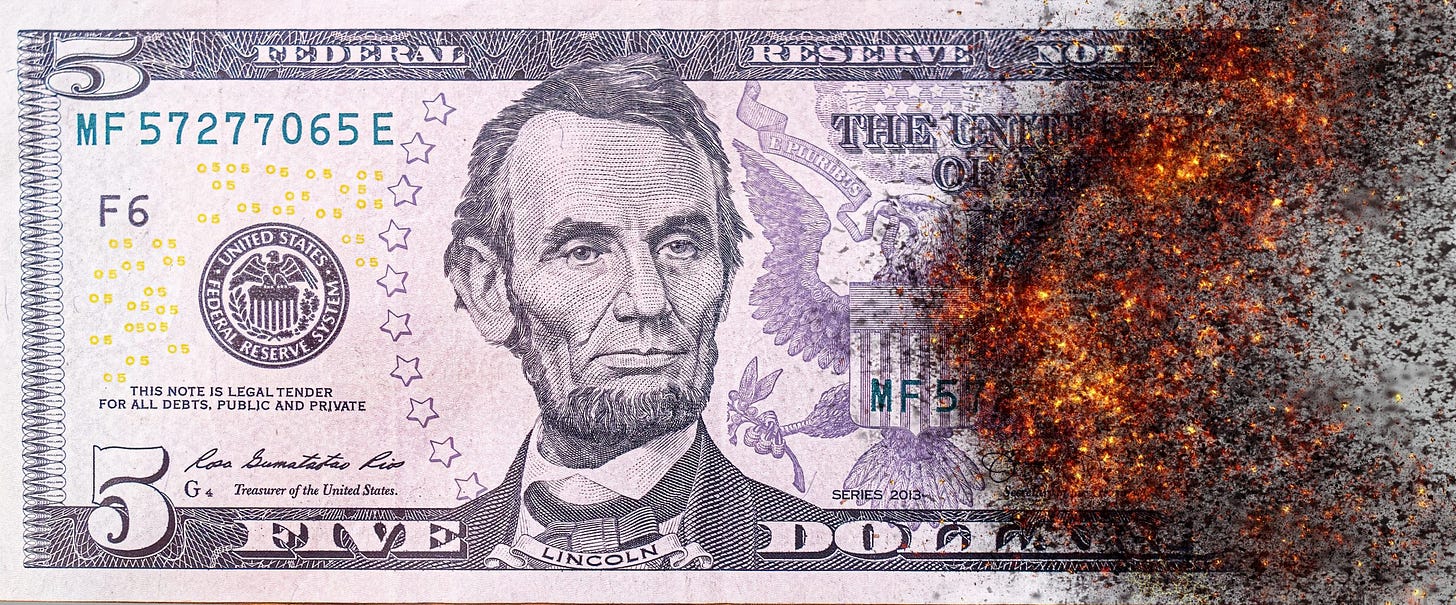The Failure of Inside Money

If you’re not prepared to be wrong, you’ll never come up with anything original. Ken Robinson, How Finding Your Passion Changes Everything.
These two young fish are swimming along and meet an older fish swimming the other way, who nods at them and says, “Morning, boys. How’s the water?” And the two young fish swim on for a bit, and then eventually, one of them looks over at the other and goes, “What the hell is water?” David Foster Wallace, in 2005 Commencement Address to Kenyon College.
One Small Step
On April 20th, SpaceX launched a 40-story tall rocket, nine metres wide, carrying 1,200 tonnes of propellant 40 km into the sky. The engineering achievement behind this event is awe-inspiring. As an evolutionary step towards our eventual colonisation of Mars, it may be as significant as the first sea creature trying to breathe out of water 400m years ago.
Elon's Truth
However, several of the Starship’s 32 Raptor engines creating 16m tonnes of thrust failed. A few minutes post-launch, it lost trajectory. The SpaceX team aborted the mission with their craft 29 miles above the Gulf of Mexico, travelling at 1,300 km/h. It exploded into a giant fireball in what they termed rapid unscheduled disassembly. Most reports represented this event as another example of the mission leader’s exaggerated claims and problematic relationship with the truth.
Life Lesson
But, the Satrship’s spectacular “failure” was a feature, not a bug. Musk said before the launch, “success is not what we should expect. That would be insane.” Scale production and rapid failure are critical to the SpaceX business model. The Company has three more Super Heavy rockets in production, nearly ready to fly. The Company maintains that such accidents are the quickest and most efficient way of gathering data. This approach sets the Company apart from its partner NASA, which, as a government agency, prefers the safety-first approach of linear product development rather than dramatic mid-flight explosions.
Fail Fast
While NASA is too important to fail, failure drives SpaceX. Its methodology is chaotic and messy but rapid and cheap. SpaceX can build 10 Super Heavy, Starship first stages, in the time it takes NASA to make a single rocket. SpaceX expects to launch and land a dozen or more Starship rockets in the next two or three years, while NASA’s method might allow a single launch.
Safety First
Like NASA, the Federal Reserve is predicated on the safety first principle. The Fed is the central bank for the World’s reserve currency, the issuer of its prime collateral, its protector from inflation and the defender of its banking system. Its work is profound. It employs over 400 PhD economists. Like NASA, much is dependent upon it, and failure is not an option.
Inside Money
The Fed endeavours to keep money safe for us to use but not necessarily to comprehend. David Foster Wallace’s parable about most fish not understanding the concept of water applies to our common conception of money. To the extent that we think about money, we think of it as our money. However, the reality is that it is someone else’s liability. What we use as money, in our pockets or bank accounts, is what Zoltan Pozsar calls inside money. And it is this type of money for which the Federal Reserve is responsible, from its creation to maintaining its purchasing power and security.
Designed to Fail
Banks form a central pillar of inside money. The credit creation they perform provides the economy’s lubricant and helps fund its growth. Pursuing adequate returns in banking involves taking both credit and duration risk. As customers, we keep our money as liabilities of leveraged bond funds with payment facilities, a seemingly irrational behaviour but one that the regulatory framework of inside money conditions us to accept as normal.
Outside Allure
Pozsar sees the cause of our current predicament as the rising allure of outside money over inside money. If the ending of all gold convertibility for the US Dollar in 1971 was the watershed moment for unfettered growth and predominance of inside money, then Pozsar believes it was last year’s G7 confiscation of Russia’s FX reserves that brought this era to a close. In his view, the World faces a crisis based on the re-emergence of commodity-based money, which Pozsar describes as a Bretton Woods III moment.
Where It Went Wrong
What Richard Nixon unleashed in 1971 was the era of financialisation, central bank domination and unfettered fiat currency. Milton Friedman and Friedrich Hayek worried about the ruinous inflationary consequences. But while Friedman’s monetarist solution to control the growth rate of monetary aggregates became broadly accepted by policymakers, Hayek’s proposals were considered too dangerously radical to contemplate.
Private Money
In 1976 (later updated), Hayek published The Denationalisation of Money, advocating the establishment of competitively issued private monies. A few years later, Hayek said, “I don’t believe we shall ever have good money again before we take the thing out of the hands of the government. That is, we can’t take it violently out of the hands of the government. All we can do is, by some sly roundabout way, introduce something that they can’t stop”.
Unresolved Double Spending
What is remarkable is that Hayek wrote about these ideas before the advent of the personal computer, the internet or any conception of a cryptographically verified and permissionless digital asset. Yet twenty years later, as the World was going Y2K and dot.com crazy, there were multiple attempts at creating private digital money. Remember beenz.com, egold, digicash, and cybercash? Bill Gates wanted to bundle digicash into his Windows operating system. But none of them could solve the double spending problem, and the intermediate winner, PayPal, was just a faster, more convenient version of inside money.
The Nakamoto Solution
In 2020 with the World’s economy turned off, we entered the final stage of the duration bubble. As rates plummeted, the future hurtled towards us, tech stocks stonked and the growth of everything digital accelerated. Working from home, food delivery, home shopping, Peleton, and the metaverse all hit warp speed, and money was no exception. Our money moves on slow rails that require permission from The Man; this would not do. Bitcoin, a utopian hobby interest that emerged following the GFC, solved this, and its wider adoption spawned a Cambrian explosion of mutated replications. Who wouldn’t want to have their own money?
Securities or Money?
One of the more prominent, well-connected crypto-chancers was Sam Bankman-Fried, or SBF, the man behind FTX. He quickly became very wealthy by convincing many rich and powerful people that he understood the alchemy of private digital money. But he was a charlatan with a warped sense of risk and no regard for private property rights.
Due Diligence
There is an essential but overlooked question to ask of any crypto-asset that jumps off the page to anyone who has read Satoshi Nakamoto’s nine-page Bitcoin White Paper. And with FTX, it took Taylor Swift to ask the vital question others had not. Can you explain why these aren’t unregistered securities?
Permanent or Transitory?
The demise of FTX epitomised the crypto-winter and the end of the wild experimentation with private digital money. Central bank officials made speeches warning that the speculative risks inherent in crypto assets must not be allowed to infiltrate the safe environment of inside money. Regulation and Central Bank Digital Currencies (CBDCs) were the answer. The same central bankers described inflation as transitory and the banking system permanent when any rational observation of the events of 2023 suggested that the reverse was true.
Always Believe
There is a familiar pattern as the dominos fall in the cascade of bank failures. At first, it is just one bad apple. Then it is a few. Then it is someone else’s fault. Blame short sellers. Goldman Sachs usually makes an appearance. But never blame the existence of inside money based on fiat currency and fractional (should it be fictional) reserve banking. Never question what water is. Never admit failure.
NASA & SpaceX
As SpaceX boldly learns one failure at a time, NASA has chosen it as its lead partner to develop the human lander for the lunar Artemis mission. Unimaginable only a few years ago, this partnership is a fascinating mixture of operating philosophies that the Federal Reserve and Treasury Department could do well to study. If inside money is heading towards its rapid unscheduled disassembly, the lifeboat it needs could be in what remains of the devastated field of cryptocurrencies. As SEC Chair Gensler and Taylor Swift have indicated, most of the 10,000 digital crypto tokens are securities under the Howey test and should be registered. But there remains one resilient exception.
A New Outside Money
A few years after its first publication, Hayek published a revised and enlarged edition of his thesis, The Denationalisation of Money: The Argument Refined. In it, he speculated that rather than entertaining an unmanageable number of currencies, markets would converge on one or only a limited number of monetary standards on which institutions would base the issue of their money. Friedrich was a visionary old fish who knew about water.
Jeremy
The post The Failure of Inside Money appeared first on Progressive.



